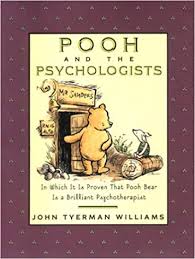Winnie-the-Pooh
| Author | Kenneth Kidd |
| Air Date | 8/2/2001 |

Winnie the Pooh Transcript
Like many children, I fell in love with Winnie the Pooh. The only stuffed animal I ever owned was my beloved Pooh Bear, who wore a bright red vest and lots of abuse [does this work?]. I knew by heart the escapades of Pooh and his friends: Piglet, Owl, Rabbit, Tigger, Eeyore, Kanga and Roo, and Christopher Robin, the real boy for whom the stories were written. I laughed when Pooh got stuck in Rabbit’s front door, when Pooh impersonated a raincloud to fool the honeybees, and when Kanga carried away Piglet in her pouch by mistake.
My parents bought me a record album entitled “Mostly Some of the Hums of Pooh,” and I still know the lyrics of songs like “Sing Ho! For the the Life of a Bear,” “Buckingham Palace,” “Three Cheers for Pooh,” and of course the classic “Cottleston Pie.” And when I was seven, my parents took me to see Pooh live at the local mall, and even though he towered above me, waving his giant honey-scooping paws, I was only a little afraid.
A. A. Milne introduced Pooh in a book called When We Were Very Young, published in 1924, followed by Winnie-the-Pooh and The House at Pooh Corner. Little did he know how wildly popular the Pooh stories would become, with adults as well as children. In fact, some very creative books for adults draw from Milne’s work, including The Tao of Pooh, The Te of Piglet, and the less well-known but funny The Pooh Perplex, a parody of literary criticism by Frederick Crews.
The latest addition to this group of adult books is John Tyerman Williams’ Pooh and the Psychologists, subtitled “In Which It is Proven That Pooh Bear is a Brilliant Psychotherapist.” Williams offers a tongue-in-cheek look at twentieth-century psychology and psychotherapy, courtesy of Pooh and company. The way Williams explains it, Pooh is a clinician whose seeming cluelessness — yes, even stupidity — is actually proof of his therapeutic genius. Pooh helps Piglet to mature, Rabbit to confront his xenophobia, Owl to communicate with the masses, and Eeyore to overcome his clinical depression. Like all good therapists, Pooh’s approach is eclectic, fashioned from Freud, Jung, Adler, Klein, Winnicott, Perls, Piaget, Lacan, and Rogers, to name a few.
Pooh Among the Psychologists completes William’s trilogy, following Pooh and the Philosophers and Pooh at the Millennium. Although he promises this is his last book, Williams reminds us that the profundity of Pooh is inexhaustible. Children, of course, already know that.